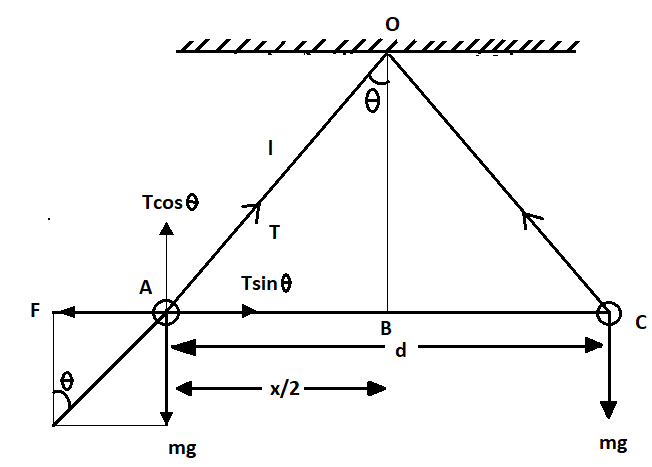Question
Question: Two identical charged spheres suspended from a common point by two massless strings of length \[l\] ...
Two identical charged spheres suspended from a common point by two massless strings of length l are initially a distance d(d<<l) apart because of their mutual repulsion. The charge begins to leak from both the spheres at a constant rate. As a result the charges approach each other with a velocity v . Then as a function of distance x between them:
A) v∝x−1/2
B) v∝x−1
C) v∝x1/2
D) v∝x
Solution
In order to solve this you have to draw a diagram first which shows the equilibrium positions of the two identical charged spheres that are suspended from a common point. Also indicate all the forces acting on two spheres and then apply the equilibrium conditions and write the equations.
Formula used:
The formula for coulombic force is given by
F=r2KQ1Q2
Where, K is the proportionality constant and K=4πε01
Q1,Q2 are the charges
r is the distance between the two charges
Complete step by step solution:

Here, in the above diagram there are two spheres A and C with identical charges q and connected to a common point O at an angle of θ with a massless string of length l and both the spheres are at a distance of d. The mass of both the spheres is given by m due to which a gravitational force mg acts downward on both the spheres and due to having identical charge a coulomb force F is acted on both the spheres equal and opposite to each other. Let us assume the tension in the string is T.
Firstly break the components of tension force and then
By applying the equilibrium condition for sphere A, we get
Tcosθ=mg ………….(i)
And, Tsinθ=F ………….(ii)
Now, on dividing both the equations (i) and (ii), we get
⇒ tanθ=mgF …………(iii)
As we know that the coulomb force is given by,
⇒ F=r2KQ1Q2
Here given that the charge is same on both the spheres, that is q
On putting all the values, we get
⇒ F=d2Kq2
Now, put the above value in equation (iii), we get
∴tanθ=d2mgKq2 ……….(iv)
It is given in the question that the charge begins to leak from both the spheres at a constant rate with a function of distance x between them. Then the above equation becomes
⇒tanθ=x2mgKq2
Now, from △AOB, we have
⇒ tanθ=l2−4x22x ……….(v)
As l>>x⇒l2>>4x2
So, neglect the term 4x2.
Hence, l2−4x2≈l2
Now, the equation (v) becomes,
⇒ tanθ=2lx …………(vi)
Now, from equation (iv) and (vi), we have
⇒ 2lx=x2mgKq2
Now write the above equation in terms of x, we have
⇒ x3=mg2Kq2l
Here, all the terms are constant except x and q
So, it is clear that,
⇒ x3∝q2
On differentiating both sides with respect to time t, we get
⇒ 23x1/2dtdx∝dtdq
Here, dtdx is the rate of change of distance, which is known as velocity. So, the charges approach each other with a velocity v.
Hence, dtdx=v and dtdq= constant
So, our above equation becomes
⇒ v∝x−1/2
Therefore, the correct option is (A).
Note: Remember that when two charges separated by a distance r0 in a vacuum and the force between them is same as the force between the same charges separated by a distance r in a medium, then from Coulomb’s Law; Kr2=r02. Also remember that the coulomb’s law is only applicable for the point charges at rest.
